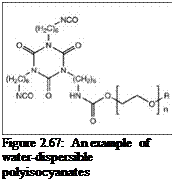 Earlier we discussed two-component polyurethane systems for sol — ventbased or high-solid systems. In general, any waterborne coating system requires resins and cross-linkers that are water dispersible. To confer water dispersibility, resins and cross-linkers are generally modified with a sufficient degree of hydrophilic groups or structures. When such modified materials are added to water under sufficient shear, they break down into discrete droplets or particles and are stabilized by the hydrophilic moieties. Thus, two-component waterborne polyurethane systems can be prepared using water — dispersible polyols (component I) and water-dispersible polyisocyanates (component II). See Figure 2.67 presents an example of the structure of water-dispersible polyisocyanates. Such components are commercially available.
Earlier we discussed two-component polyurethane systems for sol — ventbased or high-solid systems. In general, any waterborne coating system requires resins and cross-linkers that are water dispersible. To confer water dispersibility, resins and cross-linkers are generally modified with a sufficient degree of hydrophilic groups or structures. When such modified materials are added to water under sufficient shear, they break down into discrete droplets or particles and are stabilized by the hydrophilic moieties. Thus, two-component waterborne polyurethane systems can be prepared using water — dispersible polyols (component I) and water-dispersible polyisocyanates (component II). See Figure 2.67 presents an example of the structure of water-dispersible polyisocyanates. Such components are commercially available.
Component I is generally supplied as a polyol dispersion in water and component II (supplied free from water) is added to component I just prior to application.
Once the two components are mixed and the coating applied, the curing reaction begins. It is important to note that during curing, despite the presence of a large excess of water, the predominant curing reaction is between isocyanate and polyol compounds. This is mainly because of a significantly lower reaction rate of isocyanate with water compared to that
with polyols. Nevertheless, a certain degree of reaction between isocyanate and water does take place, and the cured film always contains a distribution of urethane and urea linkages.
Two-component polyurethane systems have become very popular for many commercial applications, as they can offer products with low VOC content while maintaining high performance. Such polyurethane systems are increasingly used in industrial coating applications.
 23 октября, 2015
23 октября, 2015  Pokraskin
Pokraskin  Опубликовано в рубрике
Опубликовано в рубрике 